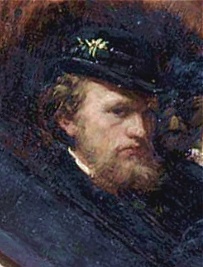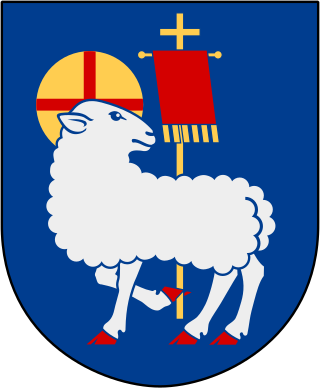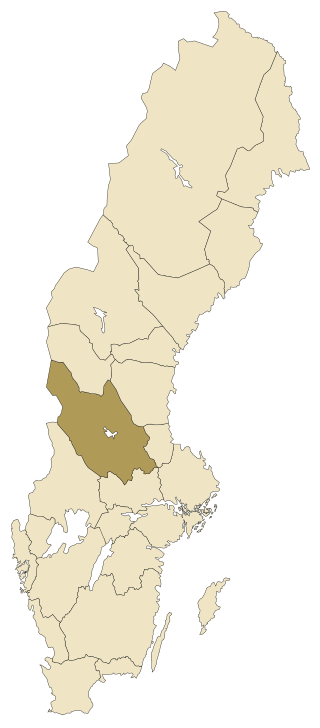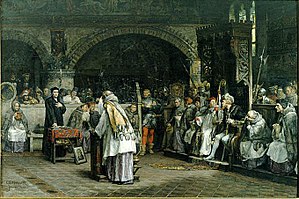
Gustav I, commonly known as Gustav Vasa, was King of Sweden from 1523 until his death in 1560, previously self-recognised Protector of the Realm (Riksföreståndare) from 1521, during the ongoing Swedish War of Liberation against King Christian II of Denmark, Norway and Sweden. Gustav rose to lead the Swedish War of Liberation following the Stockholm Bloodbath, where his father was executed. Gustav's election as king on 6 June 1523 and his triumphant entry into Stockholm eleven days later marked Sweden's final secession from the Kalmar Union.

The Church of Sweden is an Evangelical Lutheran national church in Sweden. A former state church, headquartered in Uppsala, with around 5.4 million members at year end 2023, it is the largest Christian denomination in Sweden, the largest Lutheran denomination in Europe and the third-largest in the world, after the Ethiopian Evangelical Church Mekane Yesus and the Evangelical Lutheran Church in Tanzania.

The early Vasa era is a period in Swedish history that lasted between 1523–1611. It began with the reconquest of Stockholm by Gustav Vasa and his men from the Danes in 1523, which was triggered by the event known as the Stockholm Bloodbath in 1520, and then was followed up by Sweden's secession from the Kalmar Union, and continued with the reign of Gustav's sons Eric XIV, John III, John's son Sigismund, and finally Gustav's youngest son Charles IX. The era was followed by a period commonly referred to as the Swedish Empire, or Stormaktstiden in Swedish, which means "Era Of Great Power".

Laurentius PetriNericius was a Swedish clergyman and the first Evangelical Lutheran Archbishop of Sweden. He and his brother Olaus Petri are, together with the King Gustav Vasa, regarded as the main Lutheran reformers of Sweden. They are commemorated by the Evangelical Lutheran Church in America on 19 April.

Olof Persson, sometimes Petersson, better known under the Latin form of his name, Olaus Petri, was a clergyman, writer, judge, and major contributor to the Protestant Reformation in Sweden. His brother, Laurentius Petri, became the first Evangelical Lutheran Archbishop of Sweden.

The Catholic Church in Sweden is part of the worldwide Catholic Church in communion with the Pope in Rome. It was established by Archbishop Ansgar in Birka in 829, and further developed by the Christianization of Sweden in the 9th century. King Olof Skötkonung is considered the first Christian king of Sweden.

Hans Brask (1464–1538) was a Swedish Bishop of Linköping.

Carl Gustaf Hellqvist was one of Sweden's most popular historical painters in the 19th century.

Johannes Magnus was the last functioning Catholic Archbishop in Sweden, and also a theologian, genealogist, and historian.
Laurentius Andreae was a Swedish Lutheran clergyman and scholar who is acknowledged as one of his country's preeminent intellectual figures during the first half of the 16th century. In his time he was most renowned as one of the main proponents of the Swedish reformation of 1523-31.

The Diocese of Västerås is a diocese within the Church of Sweden. Its Episcopal see is located in Västerås at Västerås Cathedral. The diocese was first established in the 12th century as part of the Roman Catholic church, but was made part of the Church of Sweden as a result of the Protestant Reformation in Sweden.

The Diocese of Strängnäs is a part of the Lutheran Church of Sweden and has its seat in Strängnäs Cathedral in Strängnäs, south of Lake Mälaren. The diocese is made up of the two provinces Närke and Södermanland.
The Uppsala Synod in 1593 was the most important synod of the Lutheran Church of Sweden. Sweden had gone through its Protestant Reformation and broken with Roman Catholicism in the 1520s, but an official confession of faith had never been declared.
Sámi schools, which were referred to as Nomad schools or Lapp schools before 1977, are a type of school in Sweden that runs parallel to the standard primary school system. Sámi schools are part of the Swedish public school system, and as such are governed by the same curriculum that primary schools are. Sámi schools are state-owned educational institutions that are open to all children whose parents identify as Sámi. Each school has its own dormitory that many students live in for large parts of the academic year due to the long distances in the north of Sweden.

The Reformation in Sweden is generally regarded as having begun in 1527 during the reign of King Gustav I of Sweden, but the process was slow and was not definitively decided until the Uppsala Synod of 1593, in the wake of an attempted counter-reformation during the reign of John III (1568–1592).

The Dalecarlian rebellions were a series of Swedish rebellions which took place in Dalarna in Sweden: the First Dalecarlian Rebellion in 1524-1525, the Second Dalecarlian Rebellion in 1527–1528, and the Third Dalecarlian Rebellion in 1531–1533. The rebellions were conducted by the peasantry of Dalarna against the Swedish monarch, King Gustav Vasa. Mutual reasons for all three rebellions were loss of support of Gustav I among the Dalecarlian peasantry because of the economic crisis, the increased royal power, and the unpopular Swedish Reformation.
Events from the year 1538 in Sweden
The Liturgical Struggle was the name for the period from 1574 until 1593 in Sweden, when there was a struggle about the confession of faith and liturgy of the Church of Sweden, brought about by the attempts of King John III of Sweden to make the Swedish church take a mediating position between Catholicism and Protestantism by holding only certain doctrines and practices which could be established immediately in either the Word of God or patristic writings, similar to what had once been imposed on the Lutheran areas in Germany during the Augsburg Interim. The struggle began in 1574, when the king introduced some new rules in the liturgy which were not by Lutheran doctrine and practice, followed by his publication of the Liturgia Svecanae Ecclesiae catholicae & orthodoxae conformia commonly called the "Red Book", which re-introduced a number of Catholic customs. The Liturgical Struggle ended with the Lutheran confession of faith at the Uppsala Synod in 1593.
Petrus Olai Dalekarlus was a Swedish academic, Dean and Member of Parliament (riksdagsman).
Peder Månsson was a Swedish author and prelate who served as the Bishop of Västerås from 1524 till 1534.













